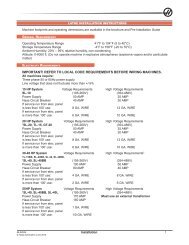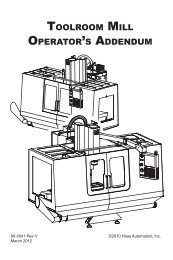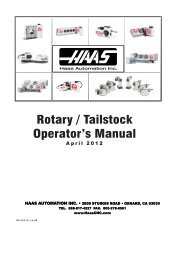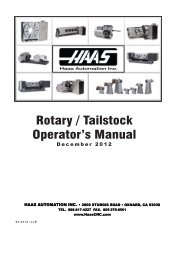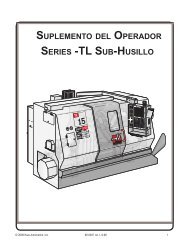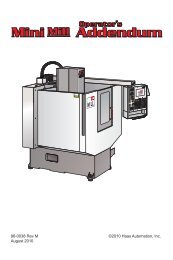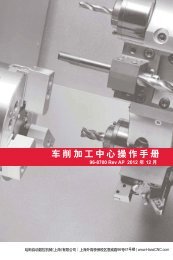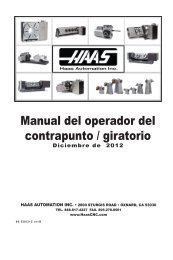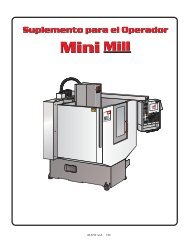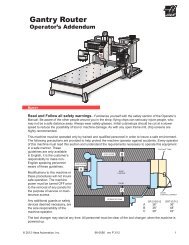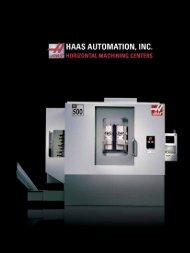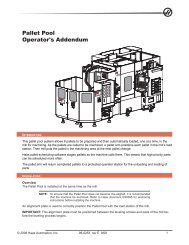Vertical mill installation instructions - Haas Automation, Inc.
Vertical mill installation instructions - Haas Automation, Inc.
Vertical mill installation instructions - Haas Automation, Inc.
You also want an ePaper? Increase the reach of your titles
YUMPU automatically turns print PDFs into web optimized ePapers that Google loves.
Use a precision bubble level with each division equal to 0.0005 inch per 10 inches, or .05 mm per meter, or<br />
10 seconds per division. Before starting, check the accuracy of your level. Set it on the table on the X axis<br />
and record the reading. Then turn it 180 o and the reading should be the same. If it is not, the level is out of<br />
calibration and should be adjusted before you continue.<br />
Rough Leveling<br />
NOTE: For the VF-1/2, it may be necessary to pull the coolant tank toward the back of the<br />
machine to access the leveling screws.<br />
1. Screw the four leveling screws at the corners through the base until the base is 2½" to 3" above the floor.<br />
That translates into a minimum of one inch of the leveling screw extending from the bottom of the machine<br />
or one inch between the pads and casting. Turn each screw until tension is about the same as on the other<br />
screws (same effort to turn each screw). Screw jam nuts onto the leveling screws, but do not tighten down.<br />
2. Install the two center leveling screws, ensuring that they do not touch the floor. Screw the jam nuts onto<br />
the leveling screws, but do not tighten them down.<br />
3. Use Handle Jog set for 0.01 on the X and Y axes for the leveling procedure. This provides a good rate of<br />
travel as you manually move the table.<br />
4. Using the jog handle, center the table under the spindle. You do not need to move the table while roughleveling<br />
the machine.<br />
5. Place the level parallel to the Y axis (side to side) on the table and observe the bubble. If the bubble is<br />
centered, the table is level on this axis. If the bubble is off to the left of the level, it means that the left side<br />
of the table is high. And, conversely, if the bubble is off to the right, it means that the right side of the table is<br />
high. Adjust the two front leveling screws until the level reads +/- 0.0005”.<br />
6. Rotate the level head so that it is parallel to the X-axis. Adjust the right front and rear leveling screws until<br />
the level reads +/-0.0005.<br />
NOTE: Make sure that the bubble has steadied before you take the reading.<br />
7. Turn the screws on the low side of the machine clockwise (screw them in) a little at a time and check the<br />
level until the bubble is centered.<br />
NOTE: In most cases it is better to raise a side or corner than it is to lower it — when you<br />
lower a machine there is a greater risk of running out of adjustment.<br />
8. Repeat the previous steps with the level on the Y axis (front to back).<br />
9. Continue this process until the machine is level on both axes.<br />
NOTE: If the level is off on both axes, it indicates that one corner of the machine is high or<br />
low.<br />
20 Installation 96-0284A<br />
© <strong>Haas</strong> <strong>Automation</strong> June 2010



